Canon SX730 vs Panasonic ZS80
The Canon PowerShot SX730 HS and the Panasonic Lumix DC-ZS80 (labelled Panasonic TZ95 in some countries) are two digital cameras that were officially introduced, respectively, in April 2017 and February 2019. Both the SX730 and the ZS80 are fixed lens compact cameras that are equipped with a 1/2.3-inch sensor. Both cameras offer a resolution of 20.2 megapixels.
Below is an overview of the main specs of the two cameras as a starting point for the comparison.

Check SX730 offers at
ebay.com

Check ZS80 offers at
ebay.com
Going beyond this snapshot of core features and characteristics, what are the differences between the Canon PowerShot SX730 HS and the Panasonic Lumix DC-ZS80? Which one should you buy? Read on to find out how these two cameras compare with respect to their body size, their imaging sensors, their shooting features, their input-output connections, and their reception by expert reviewers.
Body comparison
The physical size and weight of the Canon SX730 and the Panasonic ZS80 are illustrated in the side-by-side display below. The two cameras are presented according to their relative size. Three consecutive views from the front, the top, and the rear side are shown. All width, height and depth measures are rounded to the nearest millimeter.
Both cameras are available in two different colors (black, silver).
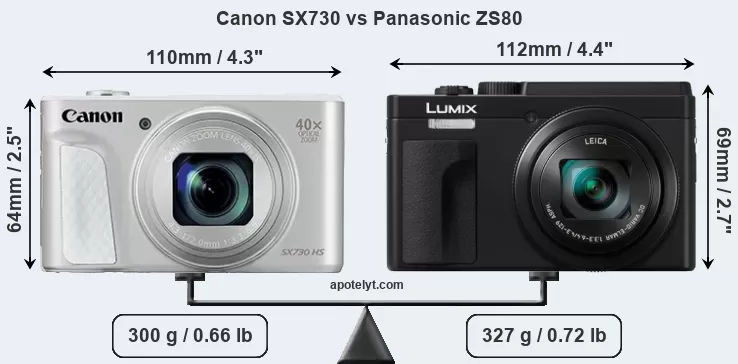
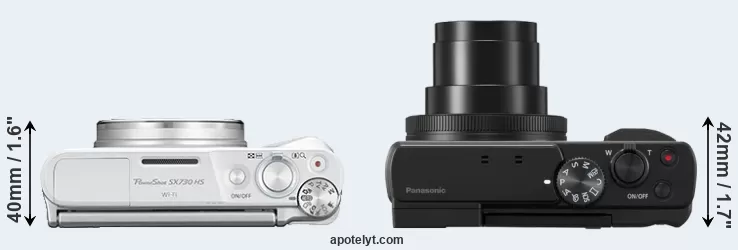
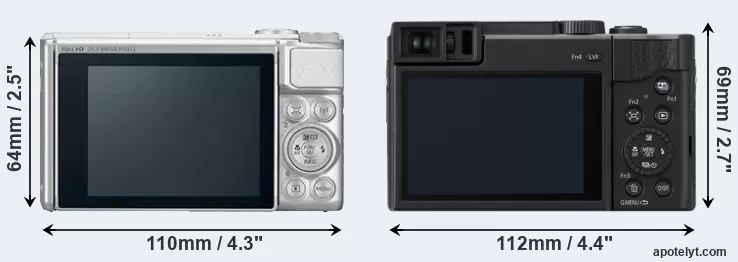
If the front view area (width x height) of the cameras is taken as an aggregate measure of their size, the Panasonic ZS80 is notably larger (10 percent) than the Canon SX730. Moreover, the ZS80 is markedly heavier (9 percent) than the SX730. In this context, it is worth noting that neither the SX730 nor the ZS80 are weather-sealed.
Concerning battery life, the SX730 gets 250 shots out of its Canon NB-13L battery, while the ZS80 can take 380 images on a single charge of its Panasonic DMW-BLG10 power pack. The battery packs of both cameras can be charged via USB, which can be very convenient when travelling.
The adjacent table lists the principal physical characteristics of the two cameras alongside a wider set of alternatives. If you want to switch the focus of the display and review another camera pair, you can move across to the CAM-parator tool and choose from the broad selection of possible camera comparisons there.

| # | Camera Model |
Camera Width |
Camera Height |
Camera Depth |
Camera Weight |
Battery Life |
Weather Sealing |
Camera Launch |
Launch Price (USD) |
Street Price |
|
|---|---|---|---|---|---|---|---|---|---|---|---|
| 1. | Canon SX730 | 110 mm | 64 mm | 40 mm | 300 g | 250 | n | Apr 2017 | 399 | ebay.com | |
| 2. | Panasonic ZS80 | 112 mm | 69 mm | 42 mm | 327 g | 380 | n | Feb 2019 | 449 | ebay.com | |
| 3. | Canon SX740 | 110 mm | 64 mm | 40 mm | 299 g | 265 | n | Jul 2018 | 399 | amazon.com | |
| 4. | Canon SX430 | 104 mm | 69 mm | 85 mm | 323 g | 195 | n | Jan 2017 | 299 | ebay.com | |
| 5. | Canon G7 X Mark II | 106 mm | 61 mm | 42 mm | 319 g | 265 | n | Feb 2016 | 699 | ebay.com | |
| 6. | Canon SX420 | 104 mm | 69 mm | 85 mm | 325 g | 195 | n | Jan 2016 | 299 | ebay.com | |
| 7. | Canon SX540 | 120 mm | 82 mm | 92 mm | 442 g | 205 | n | Jan 2016 | 399 | ebay.com | |
| 8. | Canon SX720 | 110 mm | 64 mm | 36 mm | 270 g | 250 | n | Feb 2016 | 379 | ebay.com | |
| 9. | Canon SX710 | 113 mm | 66 mm | 35 mm | 269 g | 230 | n | Jan 2015 | 349 | ebay.com | |
| 10. | Fujifilm XF10 | 113 mm | 64 mm | 41 mm | 279 g | 330 | n | Jul 2018 | 499 | ebay.com | |
| 11. | Panasonic TS7 | 117 mm | 76 mm | 37 mm | 319 g | 300 | Y | May 2018 | 449 | ebay.com | |
| 12. | Panasonic ZS70 | 112 mm | 67 mm | 41 mm | 322 g | 380 | n | Apr 2017 | 449 | ebay.com | |
| 13. | Sony HX99 | 102 mm | 58 mm | 36 mm | 242 g | 370 | n | Aug 2018 | 449 | ebay.com | |
| Note: Measurements and pricing do not include easily detachable parts, such as add-on or interchangeable lenses or optional viewfinders. | |||||||||||
The price is, of course, an important factor in any camera decision. The manufacturer’s suggested retail prices give an idea on the placement of the camera in the maker’s lineup and the broader market. The SX730 was launched at a somewhat lower price (by 11 percent) than the ZS80, which makes it more attractive for photographers on a tight budget. Usually, retail prices stay at first close to the launch price, but after several months, discounts become available. Later in the product cycle and, in particular, when the replacement model is about to appear, further discounting and stock clearance sales often push the camera price considerably down. Then, after the new model is out, very good deals can frequently be found on the pre-owned market.
Sensor comparison
The size of the imaging sensor is a crucial determinant of image quality. A large sensor will tend to have larger individual pixels that provide better low-light sensitivity, wider dynamic range, and richer color-depth than smaller pixel-units in a sensor of the same technological generation. Moreover, a large sensor camera will give the photographer more control over depth-of-field in the image and, thus, the ability to better isolate a subject from the background. On the downside, larger sensors are more costly to manufacture and tend to lead to bigger and heavier cameras and lenses.
Both cameras under consideration feature a 1/2.3-inch sensor and have a format factor (sometimes also referred to as "crop factor") of 5.6. Within the spectrum of camera sensors, this places the review cameras among the smaller-sensor digicams that favor affordability and compact design. Both cameras feature a native aspect ratio (sensor width to sensor height) of 4:3.
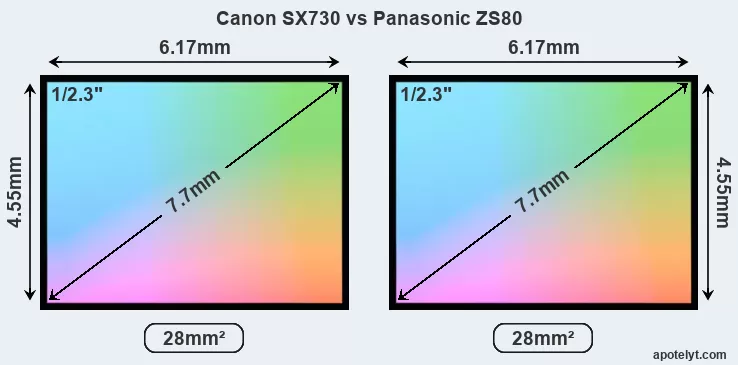
The two cameras under review do not only share the same sensor size, but also offer an identical resolution of 20.2 megapixels. This similarity in sensor specs implies that both the SX730 and the ZS80 have the same pixel density, as well as the same pixel size. It should, however, be noted that the ZS80 is a somewhat more recent model (by 1 year and 10 months) than the SX730, and its sensor might have benefitted from technological advances during this time. Coming back to sensor resolution, it should be mentioned that neither of the two cameras has an anti-alias filter installed, so they are able to capture all the detail the sensor resolves.
The Canon PowerShot SX730 HS has a native sensitivity range from ISO 80 to ISO 3200. The corresponding ISO settings for the Panasonic Lumix DC-ZS80 are ISO 80 to ISO 3200, with the possibility to increase the ISO range to 80-6400.
Technology-wise, both cameras are equipped with BSI-CMOS (Backside Illuminated Complementary Metal–Oxide–Semiconductor) sensors. Both cameras use a Bayer filter for capturing RGB colors on a square grid of photosensors. This arrangement is found in most digital cameras.
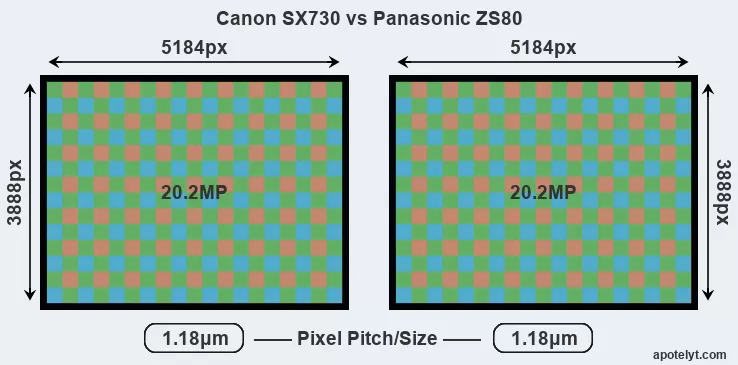
Consistent information on actual sensor performance is available from DXO Mark for many cameras. This service determines an overall sensor rating, as well as sub-scores for low-light sensitivity ("DXO Sports"), dynamic range ("DXO Landscape"), and color depth ("DXO Portrait"). The following table provides an overview of the physical sensor characteristics, as well as the sensor quality measurements for a selection of comparators.

| # | Camera Model |
Sensor Class |
Resolution (MP) |
Horiz. Pixels |
Vert. Pixels |
Video Format |
DXO Portrait |
DXO Landscape |
DXO Sports |
DXO Overall |
|
|---|---|---|---|---|---|---|---|---|---|---|---|
| 1. | Canon SX730 | 1/2.3 | 20.2 | 5184 | 3888 | 1080/60p | 20.5 | 11.9 | 924 | 50 | |
| 2. | Panasonic ZS80 | 1/2.3 | 20.2 | 5184 | 3888 | 4K/30p | 20.7 | 12.2 | 1103 | 52 | |
| 3. | Canon SX740 | 1/2.3 | 20.2 | 5184 | 3888 | 4K/30p | 20.6 | 12.1 | 1050 | 51 | |
| 4. | Canon SX430 | 1/2.3 | 19.9 | 5152 | 3864 | 720/25p | 20.5 | 11.9 | 900 | 49 | |
| 5. | Canon G7 X Mark II | 1-inch | 20.0 | 5472 | 3648 | 1080/60p | 21.8 | 11.9 | 260 | 62 | |
| 6. | Canon SX420 | 1/2.3 | 19.9 | 5152 | 3864 | 720/25p | 20.3 | 11.7 | 806 | 48 | |
| 7. | Canon SX540 | 1/2.3 | 20.2 | 5184 | 3888 | 1080/60p | 20.3 | 11.7 | 806 | 48 | |
| 8. | Canon SX720 | 1/2.3 | 20.2 | 5184 | 3888 | 1080/60p | 20.3 | 11.8 | 817 | 48 | |
| 9. | Canon SX710 | 1/2.3 | 20.2 | 5184 | 3888 | 1080/60p | 20.2 | 11.6 | 712 | 47 | |
| 10. | Fujifilm XF10 | APS-C | 24.0 | 6000 | 4000 | 4K/15p | 24.0 | 13.4 | 1844 | 83 | |
| 11. | Panasonic TS7 | 1/2.3 | 20.2 | 5184 | 3888 | 4K/30p | 20.6 | 12.1 | 1028 | 51 | |
| 12. | Panasonic ZS70 | 1/2.3 | 20.2 | 5184 | 3888 | 4K/30p | 19.1 | 10.6 | 106 | 36 | |
| 13. | Sony HX99 | 1/2.3 | 18.0 | 4896 | 3672 | 4K/30p | 20.6 | 12.1 | 1058 | 51 | |
| Note: DXO values in italics represent estimates based on sensor size and age. | |||||||||||
Many modern cameras cannot only take still pictures, but also record videos. The two cameras under consideration both have sensors whose read-out speed is fast enough to capture moving pictures, but the ZS80 provides a better video resolution than the SX730. It can shoot movie footage at 4K/30p, while the Canon is limited to 1080/60p.
Feature comparison
Beyond body and sensor, cameras can and do differ across a range of features. For example, the ZS80 has an electronic viewfinder (2330k dots), which can be very helpful when shooting in bright sunlight. In contrast, the SX730 relies on live view and the rear LCD for framing. The following table reports on some other key feature differences and similarities of the Canon SX730, the Panasonic ZS80, and comparable cameras.

| # | Camera Model |
Viewfinder (Type or 000 dots) |
Control Panel (yes/no) |
LCD Specifications (inch/000 dots) |
LCD Attach- ment |
Touch Screen (yes/no) |
Max Shutter Speed * |
Max Shutter Flaps * |
Built-in Flash (yes/no) |
Built-in Image Stab |
|
|---|---|---|---|---|---|---|---|---|---|---|---|
| 1. | Canon SX730 | none | n | 3.0 / 922 | tilting | n | 1/3200s | 5.9/s | Y | Y | |
| 2. | Panasonic ZS80 | 2330 | n | 3.0 / 1040 | tilting | Y | 1/2000s | 10.0/s | Y | Y | |
| 3. | Canon SX740 | none | n | 3.0 / 922 | tilting | n | 1/3200s | 10.0/s | Y | Y | |
| 4. | Canon SX430 | none | n | 3.0 / 230 | fixed | n | 1/4000s | 0.5/s | Y | Y | |
| 5. | Canon G7 X Mark II | none | n | 3.0 / 1040 | tilting | Y | 1/2000s | 8.0/s | Y | Y | |
| 6. | Canon SX420 | none | n | 3.0 / 230 | fixed | n | 1/4000s | 0.5/s | Y | Y | |
| 7. | Canon SX540 | none | n | 3.0 / 461 | fixed | n | 1/2000s | 5.9/s | Y | Y | |
| 8. | Canon SX720 | none | n | 3.0 / 922 | fixed | n | 1/3200s | 5.9/s | Y | Y | |
| 9. | Canon SX710 | none | n | 3.0 / 922 | fixed | n | 1/3200s | 6.0/s | Y | Y | |
| 10. | Fujifilm XF10 | none | n | 3.0 / 1040 | fixed | Y | 1/4000s | 6.0/s | Y | n | |
| 11. | Panasonic TS7 | 1170 | n | 3.0 / 1040 | fixed | n | 1/1300s | 10.0/s | Y | Y | |
| 12. | Panasonic ZS70 | 1166 | n | 3.0 / 1040 | tilting | Y | 1/2000s | 10.0/s | Y | Y | |
| 13. | Sony HX99 | 638 | n | 3.0 / 922 | tilting | Y | 1/2000s | 10.0/s | Y | Y | |
| Note: *) Information refers to the mechanical shutter, unless the camera only has an electronic one. | |||||||||||
One differentiating feature between the two cameras concerns the touch sensitivity of the rear screen. The ZS80 has a touchscreen, while the SX730 has a conventional panel. Touch control can be particularly helpful, for example, for setting the focus point.
Both cameras have an articulated rear screen that can be turned to be front-facing. This feature will be particularly appreciated by vloggers and photographers who are interested in taking selfies.The reported shutter speed information refers to the use of the mechanical shutter. Yet, some cameras only have an electronic shutter, while others have an electronic shutter in addition to a mechanical one. In fact, the ZS80 is one of those camera that have an additional electronic shutter, which makes completely silent shooting possible. However, this mode is less suitable for photographing moving objects (risk of rolling shutter) or shooting under artificial light sources (risk of flickering).
Both the SX730 and the ZS80 have zoom lenses built in. The SX730 has a 24-960mm f/3.3-6.9 optic and the ZS80 offers a 24-720mm f/3.3-6.4 (focal lengths in full frame equivalent terms). Hence, the Canon and Panasonic provide the same view at the wide-angle end, but the Panasonic has less tele-photo reach at the long end. Both cameras offer the same maximum aperture.
Concerning the storage of imaging data, both the SX730 and the ZS80 write their files to SDXC cards. The ZS80 supports UHS-I cards (Ultra High Speed data transfer of up to 104 MB/s), while the SX730 cannot take advantage of Ultra High Speed SD cards.
Connectivity comparison
For some imaging applications, the extent to which a camera can communicate with its environment can be an important aspect in the camera decision process. The table below provides an overview of the connectivity of the Canon PowerShot SX730 HS and Panasonic Lumix DC-ZS80 and, in particular, the interfaces the cameras (and selected comparators) provide for accessory control and data transfer.

| # | Camera Model |
Hotshoe Port |
Internal Mic / Speaker |
Microphone Port |
Headphone Port |
HDMI Port |
USB Port |
WiFi Support |
NFC Support |
Bluetooth Support |
|
|---|---|---|---|---|---|---|---|---|---|---|---|
| 1. | Canon SX730 | - | stereo / mono | - | - | micro | 2.0 | Y | Y | Y | |
| 2. | Panasonic ZS80 | - | stereo / mono | - | - | micro | 2.0 | Y | - | Y | |
| 3. | Canon SX740 | - | stereo / mono | - | - | micro | 2.0 | Y | - | Y | |
| 4. | Canon SX430 | - | mono / mono | - | - | - | 2.0 | Y | Y | - | |
| 5. | Canon G7 X Mark II | - | stereo / mono | - | - | micro | 2.0 | Y | Y | - | |
| 6. | Canon SX420 | - | mono / mono | - | - | - | 2.0 | Y | Y | - | |
| 7. | Canon SX540 | - | stereo / mono | - | - | mini | 2.0 | Y | Y | - | |
| 8. | Canon SX720 | - | stereo / mono | - | - | micro | 2.0 | Y | Y | - | |
| 9. | Canon SX710 | - | stereo / mono | - | - | micro | 2.0 | Y | Y | - | |
| 10. | Fujifilm XF10 | - | stereo / mono | Y | - | micro | 2.0 | Y | - | Y | |
| 11. | Panasonic TS7 | - | stereo / mono | - | - | micro | 2.0 | Y | - | - | |
| 12. | Panasonic ZS70 | - | stereo / mono | - | - | micro | 2.0 | Y | - | - | |
| 13. | Sony HX99 | - | stereo / mono | - | - | micro | 2.0 | Y | Y | Y |
Both the SX730 and the ZS80 have been discontinued, but can regularly be found used on ebay. The SX730 was replaced by the Canon SX730 HS, while the ZS80 does not have a direct successor. Further information on the features and operation of the SX730 and ZS80 can be found, respectively, in the Canon SX730 Manual (free pdf) or the online Panasonic ZS80 Manual.
Review summary
So what is the bottom line? Is the Canon SX730 better than the Panasonic ZS80 or vice versa? The listing below highlights the relative strengths of the two models.

Arguments in favor of the Canon PowerShot SX730 HS:
- Faster shutter: Has higher mechanical shutter speed (1/3200s vs 1/2000s) to freeze action.
- More tele-reach: Has a longer tele-lens for perspective compression and subject magnification.
- Easier device pairing: Supports NFC for fast wireless image transfer over short distances.
- More affordable: Was introduced into a lower priced segment (11 percent cheaper at launch).
- More heavily discounted: Has been on the market for longer (launched in April 2017).

Reasons to prefer the Panasonic Lumix DC-ZS80:
- Better video: Provides higher definition movie capture (4K/30p vs 1080/60p).
- Easier framing: Has an electronic viewfinder for image composition and settings control.
- More detailed LCD: Has a higher resolution rear screen (1040k vs 922k dots).
- Fewer buttons to press: Has a touchscreen to facilitate handling and shooting adjustments.
- Faster burst: Shoots at higher frequency (10 vs 5.9 flaps/sec) to capture the decisive moment.
- Less disturbing: Has an electronic shutter option for completely silent shooting.
- Longer lasting: Gets more shots (380 versus 250) out of a single battery charge.
- Faster buffer clearing: Has an SD card interface that supports the UHS-I standard.
- More modern: Was introduced somewhat (1 year and 10 months) more recently.
If the count of individual advantages (bullet points above) is taken as a guide, the ZS80 is the clear winner of the contest (9 : 5 points). However, the pertinence of the various camera strengths will differ across photographers, so that you might want to weigh individual camera traits according to their importance for your own imaging needs before making a camera decision. A professional wildlife photographer will view the differences between cameras in a way that diverges from the perspective of a family photog, and a person interested in architecture has distinct needs from a sports shooter. Hence, the decision which camera is best and worth buying is often a very personal one.
How about other alternatives? Do the specifications of the Canon SX730 and the Panasonic ZS80 place the cameras among the top in their class? Find out in the latest Best Superzoom Camera listing whether the two cameras rank among the cream of the crop.
In any case, while the comparison of the spec-sheets of cameras can offer a general idea of their imaging potential, it says little about, for example, the shooting experience and imaging performance of the SX730 and the ZS80 in practical situations. User reviews, such as those found at amazon, can sometimes inform about these issues, but such feedback is often incomplete, inconsistent, and biased.
Expert reviews
This is why hands-on reviews by experts are important. The following table reports the overall ratings of the cameras as published by some of the major camera review sites (amateurphotographer [AP], cameralabs [CL], digitalcameraworld [DCW], dpreview [DPR], ephotozine [EPZ], photographyblog [PB]). As can be seen, the professional reviewers agree in many cases on the quality of different cameras, but sometimes their assessments diverge, reinforcing the earlier point that a camera decision is often a very personal choice.

| # | Camera Model |
AP score |
CL score |
DCW score |
DPR score |
EPZ score |
PB score |
Camera Launch |
Launch Price (USD) |
Street Price |
|
|---|---|---|---|---|---|---|---|---|---|---|---|
| 1. | Canon SX730 | .. | + | .. | .. | 4/5 | 4/5 | Apr 2017 | 399 | ebay.com | |
| 2. | Panasonic ZS80 | .. | + + | .. | .. | 4.5/5 | .. | Feb 2019 | 449 | ebay.com | |
| 3. | Canon SX740 | .. | + | 3.5/5 | .. | 4/5 | 4/5 | Jul 2018 | 399 | amazon.com | |
| 4. | Canon SX430 | .. | .. | .. | .. | 3.5/5 | 3.5/5 | Jan 2017 | 299 | ebay.com | |
| 5. | Canon G7 X Mark II | 4.5/5 | + + | .. | 81/100 | 4.5/5 | 4.5/5 | Feb 2016 | 699 | ebay.com | |
| 6. | Canon SX420 | .. | .. | .. | .. | .. | 3/5 | Jan 2016 | 299 | ebay.com | |
| 7. | Canon SX540 | .. | .. | .. | .. | .. | .. | Jan 2016 | 399 | ebay.com | |
| 8. | Canon SX720 | .. | + | .. | .. | 4/5 | 4.5/5 | Feb 2016 | 379 | ebay.com | |
| 9. | Canon SX710 | .. | + | .. | .. | 4/5 | 3.5/5 | Jan 2015 | 349 | ebay.com | |
| 10. | Fujifilm XF10 | .. | .. | 4/5 | 75/100 | 4/5 | 4.5/5 | Jul 2018 | 499 | ebay.com | |
| 11. | Panasonic TS7 | .. | + | .. | .. | .. | 3.5/5 | May 2018 | 449 | ebay.com | |
| 12. | Panasonic ZS70 | .. | + + | .. | .. | 4/5 | 4/5 | Apr 2017 | 449 | ebay.com | |
| 13. | Sony HX99 | .. | .. | .. | .. | 4/5 | 4.5/5 | Aug 2018 | 449 | ebay.com | |
| Note: (+ +) highly recommended; (+) recommended; (o) reviewed; (..) not available. | |||||||||||
The above review scores should be interpreted with care, though. The ratings were established in reference to similarly priced cameras that were available in the market at the time of the review. Thus, a score needs to be put into the context of the launch date and the launch price of the camera, and comparing ratings of very distinct cameras or ones that are far apart in terms of their release date have little meaning. Also, kindly note that some of the listed sites have over time developped their review approaches and their reporting style.

Check SX730 offers at
ebay.com

Check ZS80 offers at
ebay.com
Other camera comparisons
Did this review help to inform your camera decision process? In case you are interested in seeing how other cameras pair up, just make your choice using the following search menu. Alternatively, you can follow any of the listed hyperlinks for comparisons that others found interesting.
- Canon R5 vs Canon SX730
- Canon S120 vs Panasonic ZS80
- Canon SX510 vs Panasonic ZS80
- Canon SX70 vs Canon SX730
- Canon SX730 vs Leica V-LUX 4
- Canon SX730 vs Nikon D3200
- Canon SX730 vs Olympus E-PL9
- Canon SX730 vs Panasonic TS7
- Fujifilm X-T30 II vs Panasonic ZS80
- Olympus E-1 vs Panasonic ZS80
- Panasonic TZ90 vs Panasonic ZS80
- Panasonic ZS80 vs Sony NEX-3
Specifications: Canon SX730 vs Panasonic ZS80
Below is a side-by-side comparison of the specs of the two cameras to facilitate a quick review of their differences and common features.
| Camera Model | Canon SX730 | Panasonic ZS80 |
|---|---|---|
| Camera Type | Fixed lens compact camera | Fixed lens compact camera |
| Camera Lens | 24-960mm f/3.3-6.9 | 24-720mm f/3.3-6.4 |
| Launch Date | April 2017 | February 2019 |
| Launch Price | USD 399 | USD 449 |
| Sensor Specs | Canon SX730 | Panasonic ZS80 |
| Sensor Technology | BSI-CMOS | BSI-CMOS |
| Sensor Format | 1/2.3" Sensor | 1/2.3" Sensor |
| Sensor Size | 6.17 x 4.55 mm | 6.17 x 4.55 mm |
| Sensor Area | 28.0735 mm2 | 28.0735 mm2 |
| Sensor Diagonal | 7.7 mm | 7.7 mm |
| Crop Factor | 5.6x | 5.6x |
| Sensor Resolution | 20.2 Megapixels | 20.2 Megapixels |
| Image Resolution | 5184 x 3888 pixels | 5184 x 3888 pixels |
| Pixel Pitch | 1.18 μm | 1.18 μm |
| Pixel Density | 71.80 MP/cm2 | 71.80 MP/cm2 |
| Moiré control | no AA filter | no AA filter |
| Movie Capability | 1080/60p Video | 4K/30p Video |
| ISO Setting | 80 - 3,200 ISO | 80 - 3,200 ISO |
| ISO Boost | no Enhancement | 80 - 6,400 ISO |
| Image Processor | DIGIC 6 | Venus |
| Screen Specs | Canon SX730 | Panasonic ZS80 |
| Viewfinder Type | no viewfinder | Electronic viewfinder |
| Viewfinder Field of View | 100% | |
| Viewfinder Magnification | 0.53x | |
| Viewfinder Resolution | 2330k dots | |
| LCD Framing | Live View | Live View |
| Rear LCD Size | 3.0inch | 3.0inch |
| LCD Resolution | 922k dots | 1040k dots |
| LCD Attachment | Tilting screen | Tilting screen |
| Touch Input | no Touchscreen | Touchscreen |
| Shooting Specs | Canon SX730 | Panasonic ZS80 |
| Focus System | Contrast-detect AF | Contrast-detect AF |
| Manual Focusing Aid | no Peaking Feature | Focus Peaking |
| Max Shutter Speed (mechanical) | 1/3200s | 1/2000s |
| Continuous Shooting | 5.9 shutter flaps/s | 10 shutter flaps/s |
| Electronic Shutter | no E-Shutter | up to 1/16000s |
| Fill Flash | Built-in Flash | Built-in Flash |
| Storage Medium | SDXC cards | SDXC cards |
| Single or Dual Card Slots | Single card slot | Single card slot |
| UHS card support | no | UHS-I |
| Connectivity Specs | Canon SX730 | Panasonic ZS80 |
| External Flash | no Hotshoe | no Hotshoe |
| USB Connector | USB 2.0 | USB 2.0 |
| HDMI Port | micro HDMI | micro HDMI |
| Wifi Support | Wifi built-in | Wifi built-in |
| Near-Field Communication | NFC built-in | no NFC |
| Bluetooth Support | Bluetooth built-in | Bluetooth built-in |
| Body Specs | Canon SX730 | Panasonic ZS80 |
| Battery Type | Canon NB-13L | Panasonic DMW-BLG10 |
| Battery Life (CIPA) | 250 shots per charge | 380 shots per charge |
| In-Camera Charging | USB charging | USB charging |
| Body Dimensions |
110 x 64 x 40 mm (4.3 x 2.5 x 1.6 in) |
112 x 69 x 42 mm (4.4 x 2.7 x 1.7 in) |
| Camera Weight | 300 g (10.6 oz) | 327 g (11.5 oz) |

Check SX730 offers at
ebay.com

Check ZS80 offers at
ebay.com
Did you notice an error on this page? If so, please get in touch, so that we can correct the information.

